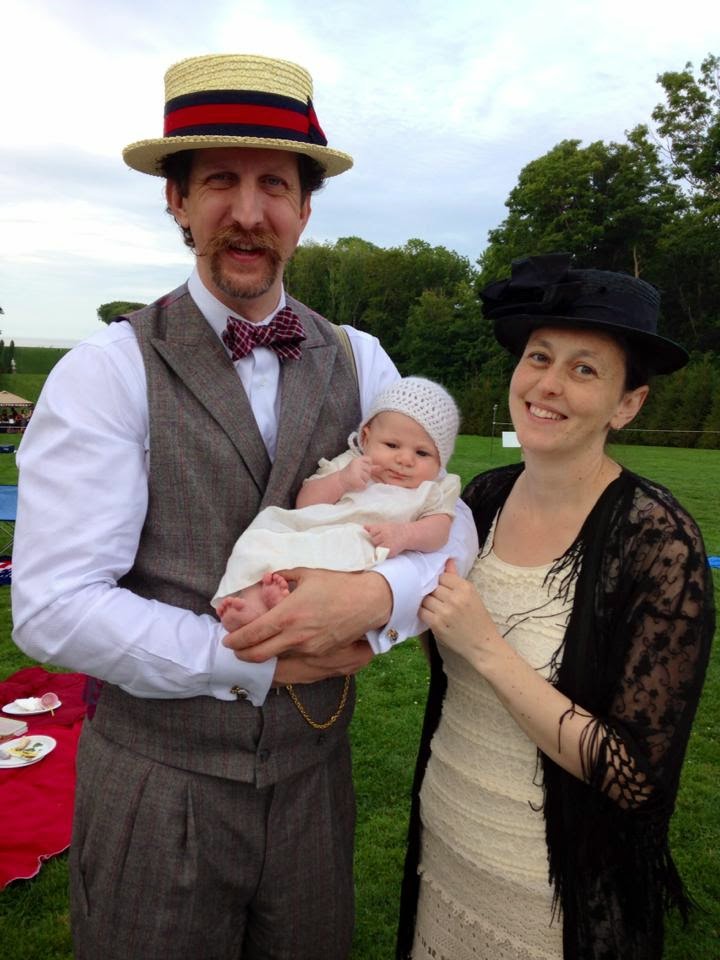Telling History: a manual for Performers and Presenters of First-Person Narratives by Joyce M. Thierer was published just a few short years ago in 2010. I did not hear about it when it came out, I did not hear about it from any museum conferences or mailing lists. I located it during a Google Books search. Since I DO first-person interpretation, and I'm fairy well connected to the pseudo-community of Living History, I was surprised I had not heard of a new book.
Telling History is very specific, it is for those that do big-audience performances, 30 - 40 minute monologues on a stage followed by question sessions at the end. I mostly do interactions in-setting of limited duration, but I'm willing to mine any resource for useful skills and info.
Thierer starts by writing an introduction to the genre, then in her first chapter talks about other types of living history and why they are inferior. She uses generalities, and worst-cases for her opinions, then writes about what she calls "Historical Performance" by calling up its best practices. A fairly messy way to justify your book. Starting with chapter 2 Thierer starts in on the "how to" stuff, and immediately references a PDF document online, on her website. She does not describe the document but continually references it for the next few chapters, practically forcing me to put down the book, wait until I had access to the Internet and enter her URL. Then the URL didn't work. Actually she had a number of different URLs, none of the ones I tried worked. The book does have appendices, I don't understand why the worksheets could not be included in the appendix, with the amount they were referenced.
All that being said, I do still think the book is worth reading. Thierer's guidance on how to pick a person to portray and how to do historical research would be very useful for those just starting out. I found her script writing chapter very informative, and made me think I could actually write my own script to present an interesting historical program. I am not as big a fan of the sit-for-40-minutes sort of program, but if someone manages to follow all of Thierer's best practices, I bet the performance would be pretty good.
I found her chapter on business to be the hardest to get through. It was long, and not as good as a book on the subject of starting a business. Yes, historical theater is unique, I wish she had concentrated on just those parts that were unique. The following chapter, written for museums and other institutions, was much shorter, and crammed full of useful information for the institution and those that want to be hired. Thierer's list of questions that every institution should ask before hiring a performer (and that every performer should be able to answer) is challenging, geared towards those who do a lot of scholarship, and are really professional. It is an aspirational list for those of us not employed as college professors.
Her final chapter is the most ambitious, but possibly the most inspiring. She writes about her dreams for historical theater and includes reaching wider audiences, and a professional organization that develops standards and provides training. These have been goals of mine at some point or another, though at this point I have found enough small groups or institutions doing these things that it is now my goal to organize the groups, or at least make sure people know they exist.
She sticks to basically just two example performances that she keeps returning to: her own experiences playing Calamity Jane, and her partner's experiences as Amelia Earhart. This allows for continuity, but got a bit boring after a while. She was very focused on American History, and specifically mid-west history, but this is what she knows. Those of us who have different geographic or temporal focus can still use a lot of what she presents, just know that the bits on costuming, picking themes, identifying research material can vary widely from her examples.
Thierer's book is well written. It is easy to read just a chapter at a time, but if you stop in the middle of a chapter be prepared to go back and at least skim when you pick it back up. Her book is ambitious and assumes some pretty high standards. These are both good things.
Anyone involved in Living History who is looking to find the book that best describes their own experiences is in for a long search. I have become a gleaner of advice and information, picking up bits from all the diverse books out there. Though Thierer's book is very specifically for those doing performance monologues, there is plenty to be gleaned for those of us who do other sorts of Living History.
Read this entry on entry page








